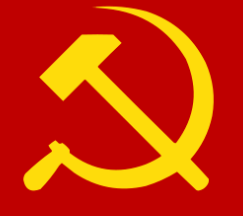mNo edit summary Tag: Visual edit |
m (Added image and category.) Tag: Visual edit |
||
| Line 1: | Line 1: | ||
[[File:Communist symbol stalin flag.png|right|frameless|213x213px]] | |||
The hammer and sickle (Unicode: "☭") is a symbol meant to represent [[Proletariat|proletarian]] [[solidarity]] – a union between the [[peasantry]] and [[Proletariat|working-class]]. It was first adopted during the [[October Revolution|Russian Revolution]], the hammer representing the workers and the sickle representing the peasants.[https://www.britannica.com/topic/flag-of-Union-of-Soviet-Socialist-Republics [1<nowiki>]</nowiki>] | The hammer and sickle (Unicode: "☭") is a symbol meant to represent [[Proletariat|proletarian]] [[solidarity]] – a union between the [[peasantry]] and [[Proletariat|working-class]]. It was first adopted during the [[October Revolution|Russian Revolution]], the hammer representing the workers and the sickle representing the peasants.[https://www.britannica.com/topic/flag-of-Union-of-Soviet-Socialist-Republics [1<nowiki>]</nowiki>] | ||
| Line 15: | Line 16: | ||
===== Gear, machete ===== | ===== Gear, machete ===== | ||
* [[Angola]] | * [[Angola]] | ||
[[Category:Marxist symbols]] | |||
Revision as of 15:38, 21 August 2022

The hammer and sickle (Unicode: "☭") is a symbol meant to represent proletarian solidarity – a union between the peasantry and working-class. It was first adopted during the Russian Revolution, the hammer representing the workers and the sickle representing the peasants.[1]
Variations
Different parties and countries have adapted the hammer and sickle to their conditions, including: